“Sports do not build character. They reveal it.” John Wooden’s words perfectly describe soccer stadiums around the world. These places are where games, cultures, histories, and fan passions come together. As we look ahead to 2024, the world’s largest soccer stadiums are more than just buildings. They are huge arenas where millions of fans gather to witness unforgettable moments.
These massive venues are key in creating the excitement and atmosphere of the sport. With soccer’s growing popularity, more and more people are watching. Last season, 229 million people in Europe watched football, with 111 million watching top-tier games. This is a 1.1% increase from the previous season1.
Soccer venue highlights are now more important for fans everywhere. These stadiums are not just for games. They represent the spirit and passion of soccer.
Let’s dive into the world of global stadium rankings. We’ll celebrate the biggest stadium capacity and the stories behind these epic venues.
Introduction to the World’s Biggest Soccer Stadiums
Soccer is more than a game; it’s a global phenomenon. It’s about massive stadiums that symbolize culture and pride. These places are key in shaping soccer culture, offering fans and athletes unforgettable moments.
These stadiums are not just about size or design. They are the heart of excitement and passion. They host some of the most memorable games in history.
Soccer stadiums have unique features that draw millions each year. They create an electric atmosphere, with fans cheering in unison. These stadiums capture the spirit of soccer, blending tradition and modernity.
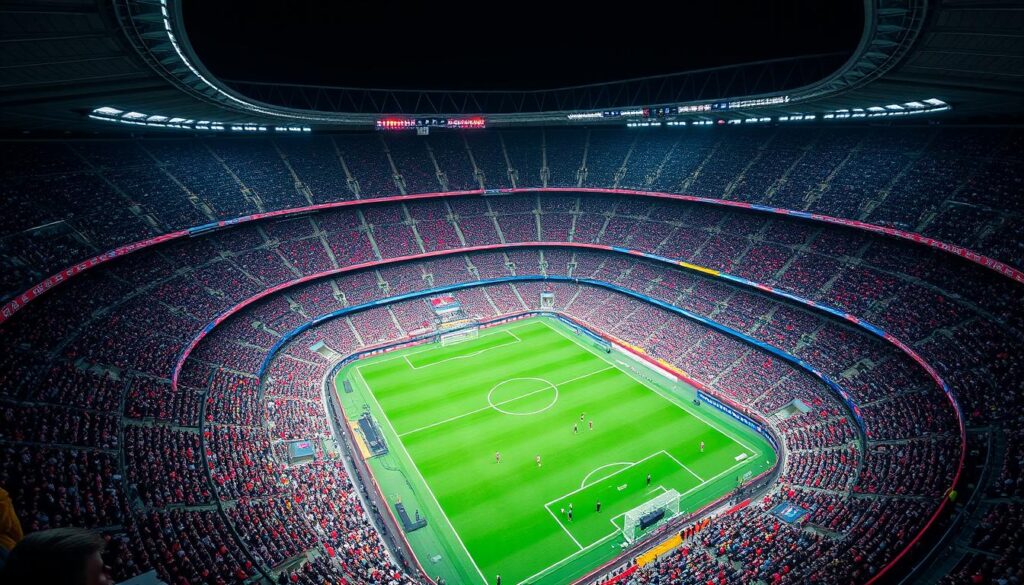
Exploring the biggest soccer stadiums reveals their power to unite communities. They inspire generations and tell stories of dreams and aspirations. These venues are more than just sports venues; they are hubs for cultural exchange and celebration234.
Criteria for Measuring Stadium Size
Knowing how to measure stadium size is key for fans and sports pros. The number of seats shows how many people can watch games, affecting money and community ties. Seating setups greatly impact fan experiences at events.
Seating Capacity Explanation
Seating capacity is the first thing people think of when looking at stadiums. Bigger stadiums can hold more fans, showing their big role in sports. Capacities vary from a few thousand to over 100,000, showing the wide range of sizes worldwide.
Seat types, like general or premium, also matter. They help figure out how many seats are available.
Overall Dimensions and Area
Stadium size isn’t just about seats. It also includes the field, player areas, and food stands. Sizes differ a lot; some are huge, others cozy. It’s key to weigh seat numbers against the whole layout.
| Stadium | Seating Capacity | Field Dimensions | Total Area (sq ft) |
|---|---|---|---|
| Rungrado 1st of May Stadium | 114,000 | 105m x 68m | 20,000,000 |
| Camp Nou | 99,354 | 105m x 68m | 25,000,000 |
| Wembley Stadium | 90,000 | 105m x 68m | 30,000,000 |

Top Soccer Stadiums: A Global Perspective
The world of soccer is filled with amazing venues that impress fans and players. These stadiums are more than places to watch games; they are cultural symbols. They show the passion of soccer fans around the world.
Places like Camp Nou in Barcelona and the Maracanã in Rio de Janeiro are famous for their size and history. They have hosted huge matches. These stadiums give a peek into the spirit of their communities and the excitement of big events. With over 80,000 seats, they connect fans from everywhere.
Stadiums like the Allianz Arena in Munich and Wembley Stadium in London offer more than soccer. They host big tournaments and concerts. These venues have top-notch amenities and technology, making the experience better for everyone. Each stadium has its own special touch, whether through design or famous rivalries.
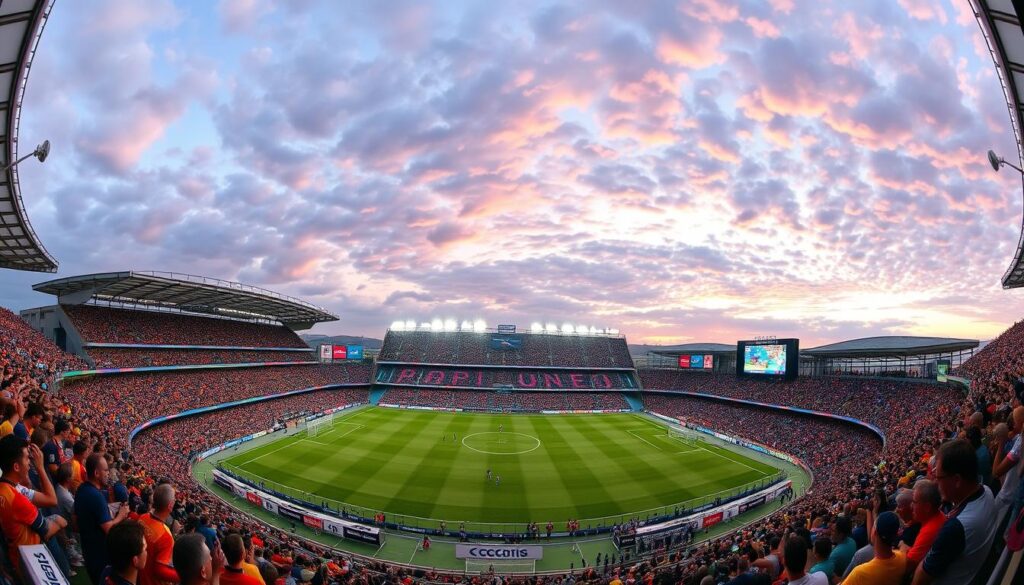
Exploring these amazing stadiums shows how they shape soccer’s global story. From small local arenas to huge international stadiums, each plays a big role. The changing nature of soccer venues keeps making watching games exciting and connected to a global story. A recent case involving racism in a Mallorca fan shows the need for safe and welcoming stadiums5.
| Stadium | Location | Capacity | Significant Event |
|---|---|---|---|
| Camp Nou | Barcelona, Spain | 99,354 | FC Barcelona Matches |
| Wembley Stadium | London, England | 90,000 | FA Cup Finals |
| Maracanã | Rio de Janeiro, Brazil | 78,838 | FIFA World Cup Finals |
| Allianz Arena | Munich, Germany | 75,024 | UEFA Champions League Matches |
Top 10 Biggest Soccer Stadiums in the World 2024
Finding the top 10 biggest soccer stadiums in the world 2024 is a detailed task. We look at seating capacity, historical value, and architectural beauty. This section highlights the unique features of each stadium.
Overview of the Selection Process
Choosing the largest stadiums is a careful process. We check their seating capacity and modern features. We also consider their historical importance and design. This creates a list of the world’s top soccer venues.
Key Highlights of Each Stadium
- Rungrado 1st of May Stadium: This North Korean stadium holds over 114,000, the largest in the world.
- Camp Nou: Home of FC Barcelona, it seats about 99,354. Its design attracts millions every year.
- FNB Stadium: Famous for the 2010 FIFA World Cup, it can hold up to 94,736 fans.
- Wembley Stadium: With a capacity of 90,000, it’s known for its arch and historic games.
- Estadio Azteca: This Mexican stadium hosted two World Cups and seats 87,523, a soccer milestone.
- Gelora Bung Karno Stadium: In Indonesia, it can hold 88,306 and hosts big events.
- Signal Iduna Park: Known for its lively atmosphere, it seats 81,365 fans and is Borussia Dortmund’s home.
- Allianz Arena: This German stadium can host 75,000 and is Bayern Munich’s home.
- Stade de France: France’s largest stadium, it seats 81,338 and hosts international events.
- MetLife Stadium: Not just for soccer, this US stadium can host 82,500 fans, even though it’s not its main sport.
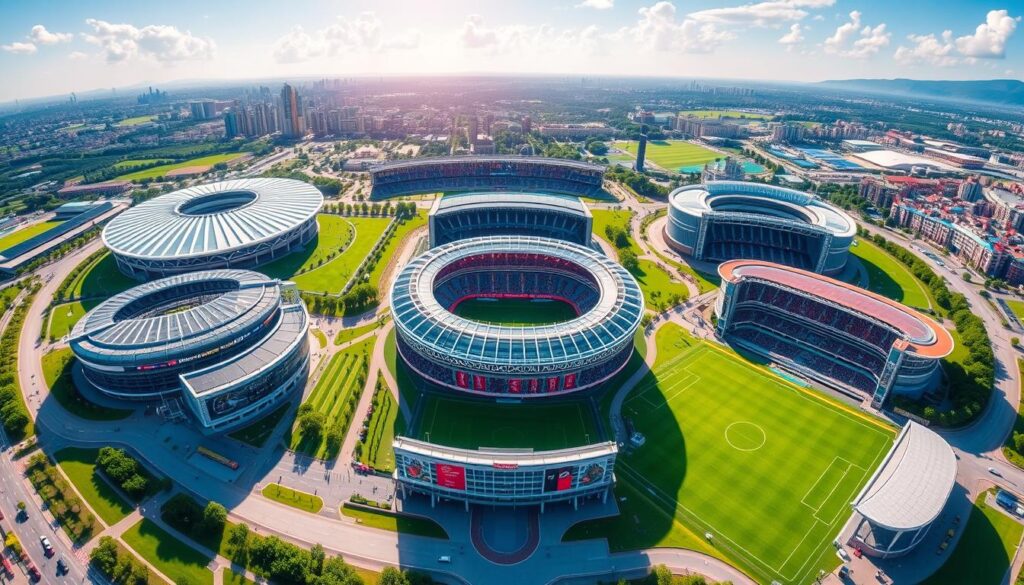
“The average capacity of the top 10 biggest soccer stadiums in the world in 2024 shows significant contributions to their hosting capabilities.”6
Camp Nou: The Home of FC Barcelona
Camp Nou FC Barcelona is at the heart of soccer culture. It’s a symbol of pride and passion. The stadium is more than just a place to watch games; it’s where fans gather and unforgettable moments happen.
Historical Significance
Since 1957, Camp Nou has been the largest stadium in Europe. It’s seen moments that changed soccer history. The stadium’s size lets fans feel the excitement of live games.
Legends have been made here, and rivalries have started. It’s a place where dreams come true.
Notable Matches and Events
Camp Nou has hosted many games that left a mark on soccer. It’s seen intense matches, especially against Real Madrid. Events like UEFA Champions League games have shown the skill and stakes.
Every game adds to Camp Nou’s rich history. It’s a top spot for soccer fans7.
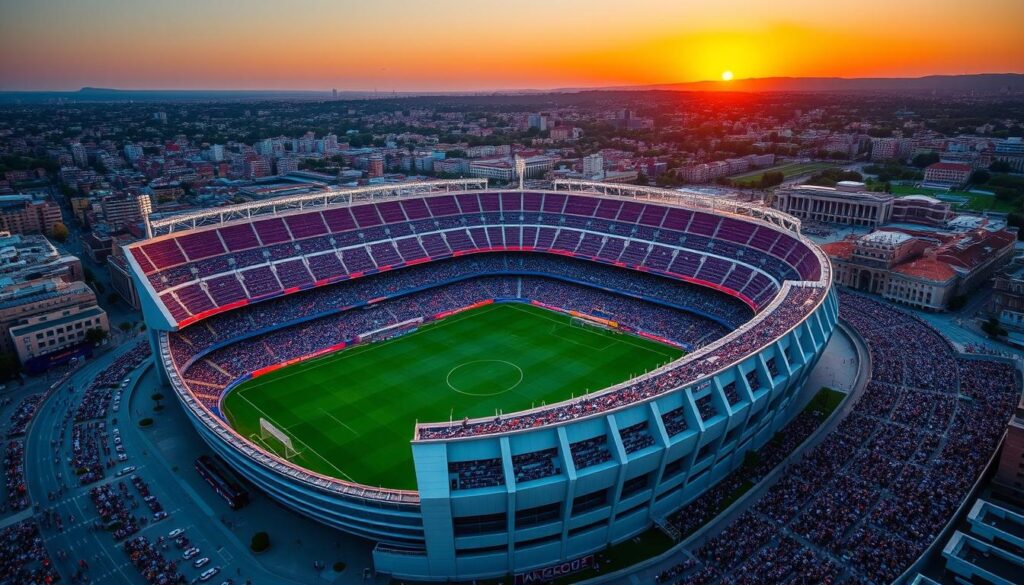
Rungrado 1st of May Stadium: North Korea’s Giant
The Rungrado 1st of May Stadium is in P’yŏngyang, North Korea. It’s one of the biggest stadiums in the world, with over 100,000 seats8. It’s not just a sports venue but also a symbol of North Korea’s grandeur and athletic achievements.
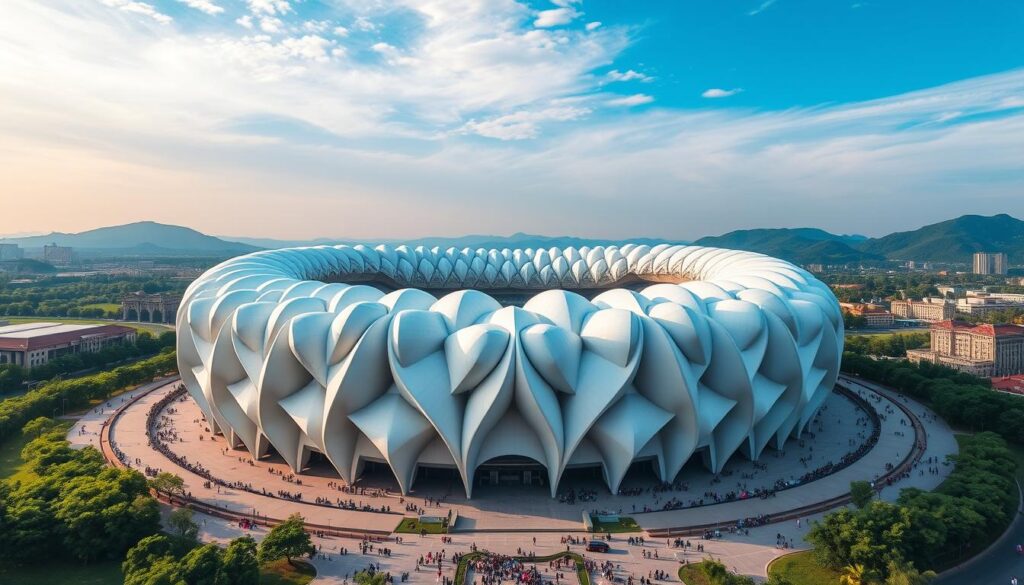
Built in 1989, the stadium looks like a magnolia blossom. This design makes it stand out8. It hosts soccer, athletic events, and cultural shows. It’s a key part of North Korean sports culture.
The stadium is important for international events. It shows North Korea on the world stage8. It has hosted big competitions, boosting national pride. It’s a must-see for tourists and sports fans in North Korea.
| Stadium Name | Location | Seating Capacity | Year Opened |
|---|---|---|---|
| Rungrado 1st of May Stadium | P’yŏngyang, North Korea | 100,000+ | 1989 |
| Melbourne Cricket Ground | Melbourne, Australia | 100,024 | 1853 |
| Aztec Stadium | Mexico City, Mexico | 87,523 | 1966 |
| Salt Lake Stadium | Kolkata, India | 85,000 | 1984 |
| Michigan Stadium | Ann Arbor, USA | 107,601 | 1927 |
Wembley Stadium: Icon of London
Wembley Stadium is a key part of London, known for its history and design. It opened in 2007 with a unique arch that symbolizes modern stadiums. With 90,000 seats, it’s one of the biggest stadiums worldwide, hosting many events each year.
Architectural Features
The arch at Wembley Stadium is 315 meters long, showing the spirit of English football. The roof can open and close, making it versatile for events. Every seat offers a great view, making the experience unforgettable for fans.
Memorable Events Held Here
Wembley Stadium has hosted many big events, like FA Cup finals and international soccer matches. It’s also known for legendary concerts and World Cup finals. These events add to its rich history, making it a top spot for sports and music fans.
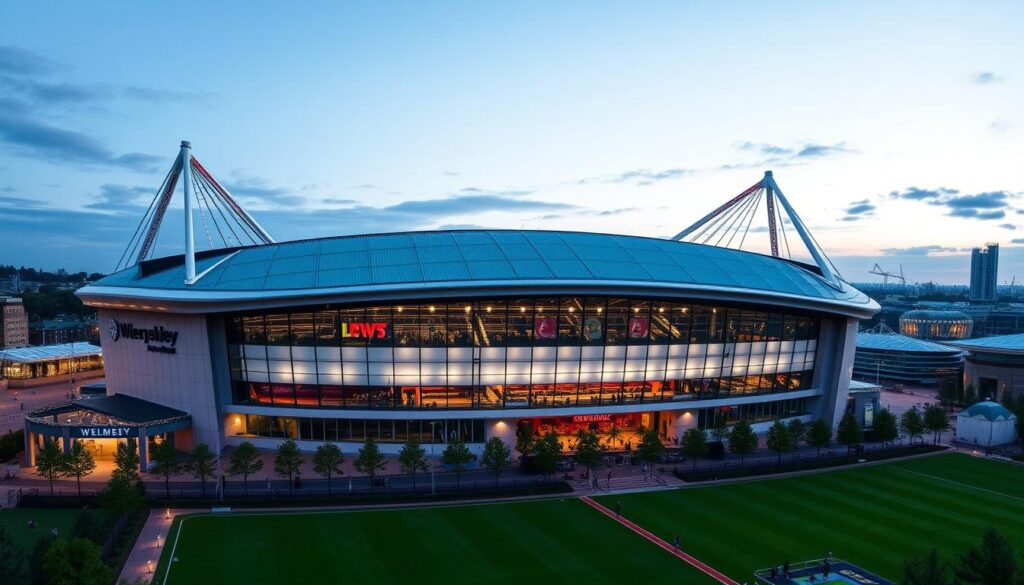
FNB Stadium: A South African Landmark
The FNB Stadium is in Johannesburg and is a key part of South Africa’s sports scene. It has a huge seating capacity of 94,736, making it Africa’s biggest football stadium. It shows the country’s deep love for soccer9.
Its design and lively vibe make it a big part of local culture and international sports. It’s a place where sports and culture meet.
Role in the 2010 FIFA World Cup
The stadium became famous during the 2010 FIFA World Cup, hosting the final match10. This was a big moment in FIFA World Cup history. It showed South Africa was ready to host such a big event.
The World Cup’s success boosted soccer in South Africa. It made FNB Stadium a symbol of South Africa’s sports history9.
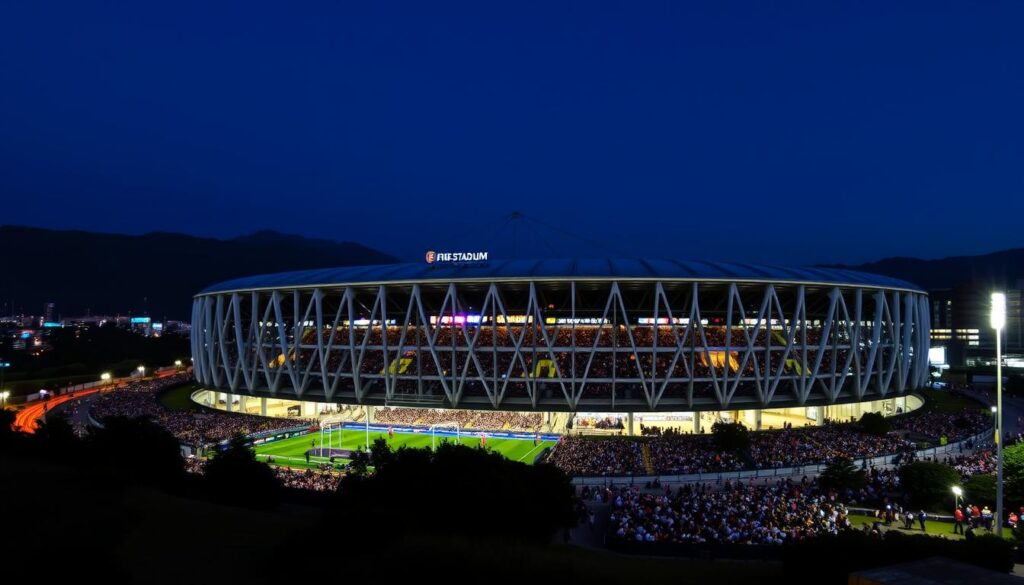
Estadio Azteca: A Mexican Marvel
The Estadio Azteca is a key part of Mexican soccer history. It has hosted two FIFA World Cup tournaments, in 1970 and 1986. These events were major milestones in soccer’s growth. The stadium is famous worldwide, thanks to its role in the World Cup.
Importance in World Cup History
Estadio Azteca is known for its stunning design and unforgettable games. Diego Maradona’s “Hand of God” goal in 1986 is a legendary moment. This goal shows the stadium’s impact on soccer history.
Current Capacity and Modern Upgrades
The Estadio Azteca can hold about 87,000 fans, making it one of the biggest stadiums. It has seen updates like better seats, facilities, and technology. These changes aim to enhance the fan experience while keeping its historical charm.
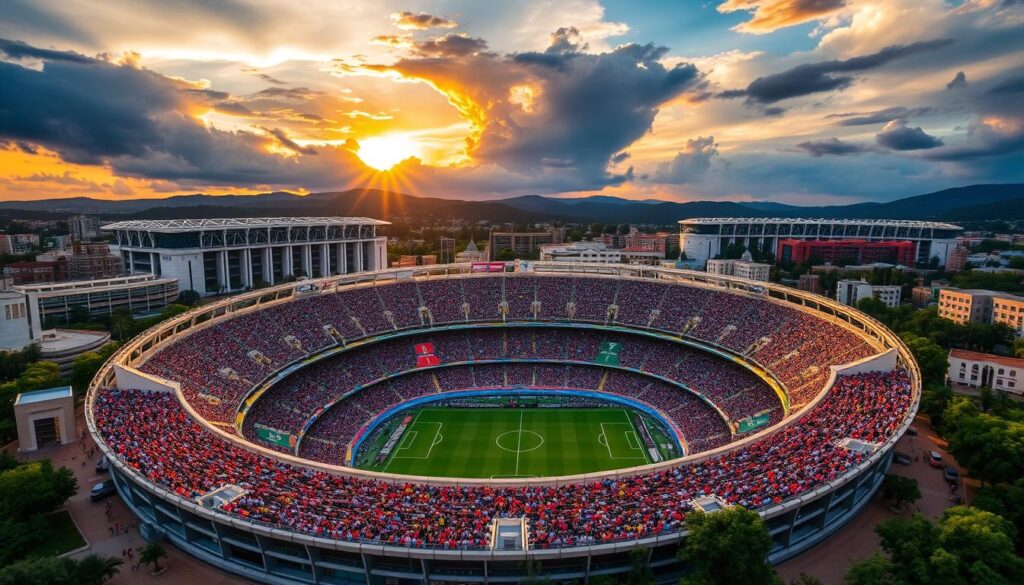
As the Estadio Azteca continues to host big events, it remains crucial in both Mexican soccer history and global culture11.
Gelora Bung Karno Stadium: Indonesia’s Pride
The Gelora Bung Karno Stadium is a huge symbol of Indonesian sports and culture. It can hold about 88,000 people. It’s the biggest in Indonesia and one of the biggest in Southeast Asia.
The design of the stadium mixes modern and traditional Indonesian styles. It’s a special place for big events, like the Asian Games. It shows Indonesia’s love for sports.
This stadium is also very important for the Indonesian people. It’s where big sports moments happen, making everyone proud. The energy at soccer games is amazing, showing how much fans love their teams.
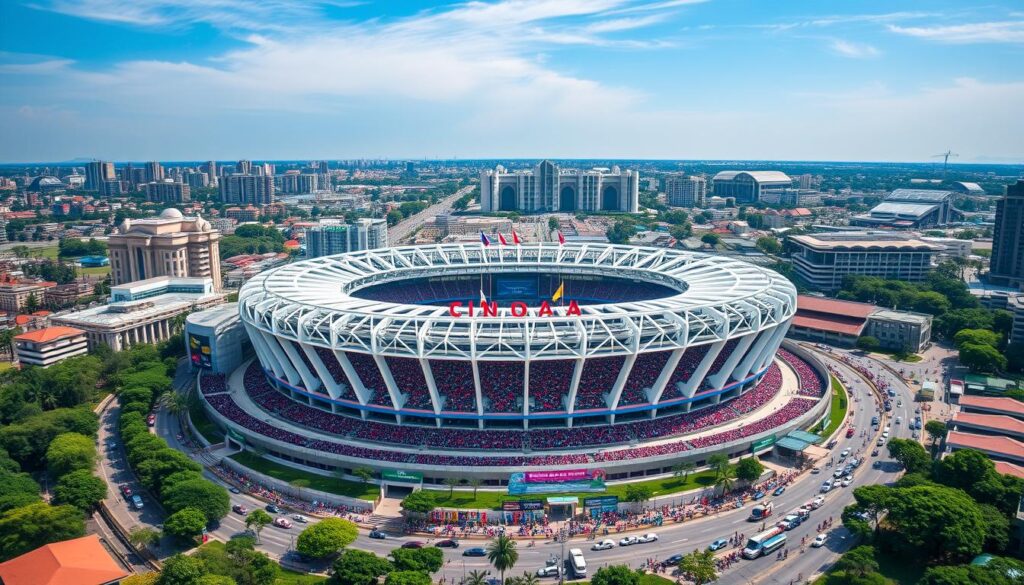
| Feature | Description |
|---|---|
| Location | Jakarta, Indonesia |
| Capacity | 88,000 |
| Opened | 1962 |
| Events Hosted | Asian Games, SEA Games, International Soccer Matches |
| Cultural Impact | Symbol of national pride and unity |
The Gelora Bung Karno Stadium is key for Indonesian sports and culture. It’s a big part of Asia’s sports world. As Indonesia grows in sports, the stadium keeps being the heart of its athletic spirit12.
Signal Iduna Park: The Borussia Dortmund Venue
Signal Iduna Park, also known as Westfalenstadion, is a key part of soccer culture in Germany. It’s a famous place for Borussia Dortmund. With a huge seating capacity of 81,365, it’s one of the biggest stadiums in Europe and the third-largest soccer stadium in 20241314.
This stadium is loved for its size and the amazing *soccer atmosphere* it has, especially during home games.
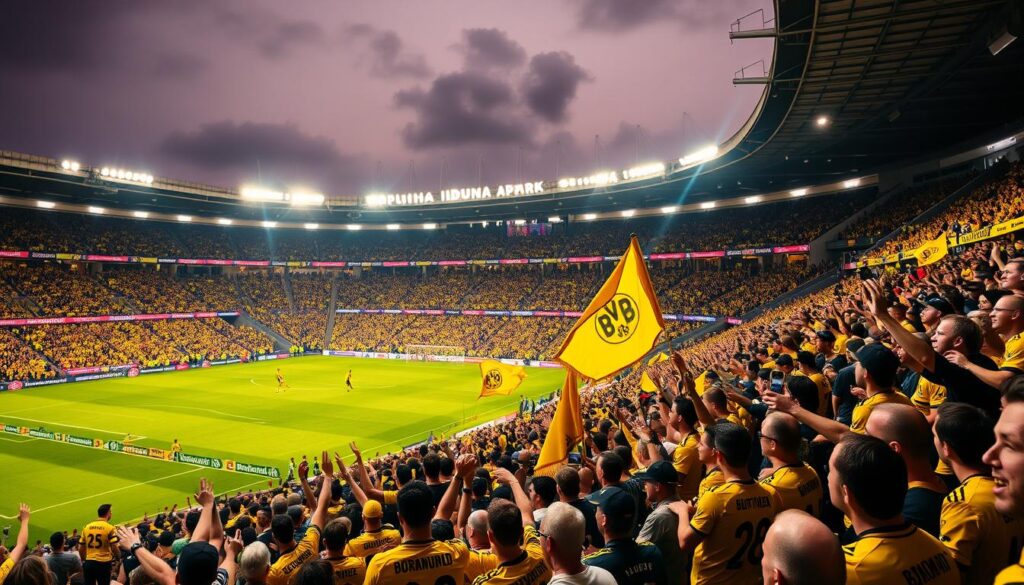
Famous for its Atmosphere
The *soccer atmosphere* at Signal Iduna Park is electric. It’s thanks to the famous “Yellow Wall,” a south stand with over 25,000 fans. It’s the largest free-standing grandstand in Europe13.
This section of the stadium brings energy to both players and fans. People say it’s a life-changing experience. The chants and cheers fill the air.
Signal Iduna Park is also a top UEFA venue, showing its great facilities13. It has hosted many international games, including FIFA World Cup events. Over 45 years, it has seen many historic football moments, making it Borussia Dortmund’s home since 197413.
“The atmosphere at Signal Iduna Park is unlike any other. You feel the passion of the fans, which is an experience that truly defines football.”
Signal Iduna Park is a symbol of football heritage. Its huge capacity, enthusiastic crowds, and strong community spirit make it a standout venue worldwide.
Allianz Arena: Bayern Munich’s Iconic Stadium
The Allianz Arena is a top soccer venue, known as Bayern Munich’s home. It holds about 75,000 fans, making it one of the biggest stadiums globally15. This stadium is famous for its amazing features and draws huge crowds, making it a key spot in European soccer15.
The stadium is known for its top-notch facilities, offering a great experience for visitors. Its location attracts fans from all over, making it a must-visit for soccer lovers and tourists15.
The arena hosts many events, not just soccer games. This makes it a big earner from ticket sales, merchandise, and food. Its ability to host different events shows its importance and Bayern Munich’s rich soccer history15.
![]()
The Allianz Arena is known for its beautiful design and stands as a symbol of German soccer greatness. It’s a top choice for big events and shows Bayern Munich’s pride worldwide.
Stade de France: Hosts of Major International Events
The Stade de France is a top spot for international sports, drawing thousands yearly. It’s known for its huge capacity and special features. Since opening for the 1998 FIFA World Cup, it’s a symbol of sports greatness in France.
Capacity and Unique Features
The Stade de France can hold over 80,000 fans, making it one of Europe’s biggest stadiums16. It’s famous for its flexible design, with a movable roof for different events all year16. It also has an athletics track, perfect for big events like the Diamond League Athletics Championships16.
It’s hosted big games like the UEFA Euro 2016 final and the 1999 UEFA Champions League Final16. The Stade de France also hosts concerts and cultural events16. A museum inside tells its story, offering guided tours16. Easy public transport makes getting there a breeze16.
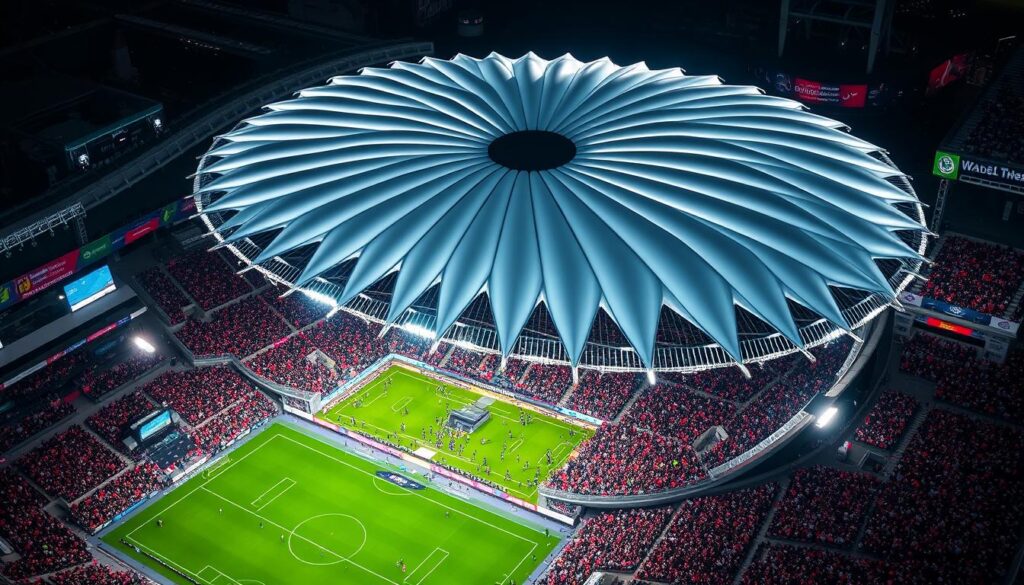
France is aiming to host more international events, and the Stade de France has a strong track record17. It’s been home to the Champions League final three times17. With Italy and other French stadiums in the running, the Stade de France remains a top choice17.
Factors Influencing Stadium Rankings Worldwide
Stadium rankings worldwide depend on economic influence and cultural importance. Big stadiums boost local economies by attracting tourists and supporting businesses. They also create jobs, helping cities thrive during events like soccer games and concerts.
Economic Impact of Large Stadiums
The economic role of soccer venues is huge. A good stadium can add millions to a city’s income, especially in tourist spots. Stadium projects also improve local services, helping communities.
Jobs at stadiums cover many areas, like hospitality and security. Hosting big events raises a place’s reputation worldwide. This is a big win for the location.
Cultural Significance in Host Countries
Culture and economics are closely linked in stadium importance. Stadiums are symbols of national pride and community identity. They show off local culture and history to the world.
They make people feel connected and encourage community involvement. Famous soccer venues are like holy sites for fans. They play a big role in local and national culture.
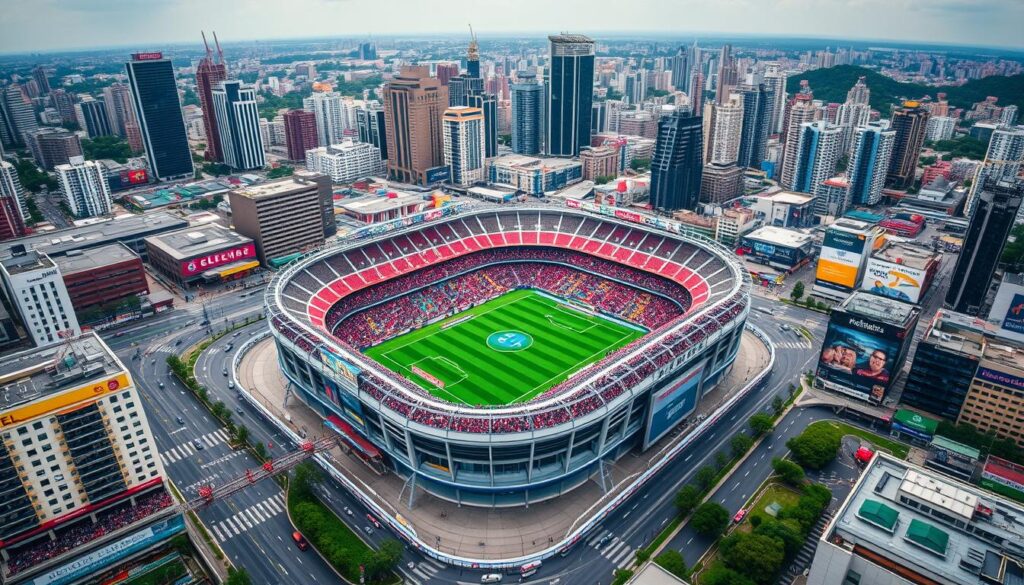
The Future of Soccer Stadiums: Trends to Watch
Soccer stadiums are changing fast, thanks to new tech and design ideas. Soon, stadiums will look and feel better, making games more fun for fans. They will also be kinder to the planet, using green practices in their design.
Innovations in Design and Technology
New stadiums will have cool tech that changes how we watch games. You’ll see augmented reality, fast Wi-Fi, and apps that show stats and stories live. This tech makes watching games more exciting and personal.
Stadiums will also have flexible seats and parts that can change for different events. They’ll focus on making fans comfortable and welcome everyone. Plus, they’ll use green materials and save energy, showing they care about the planet.
In short, soccer stadiums are getting better, focusing on fun and being green. With new tech and designs, watching soccer will be more fun and good for the earth18.
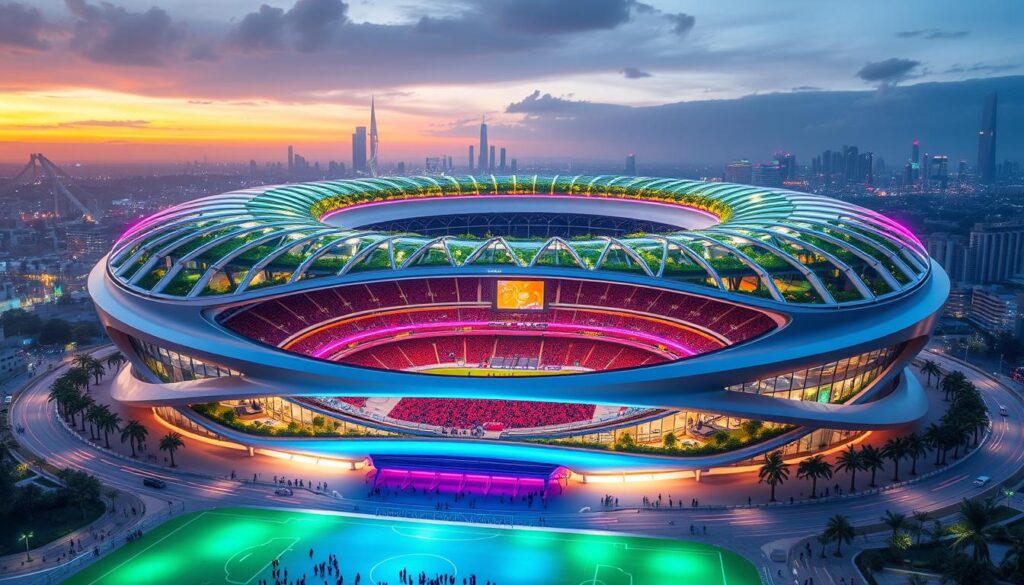
Final Thoughts on the Largest Soccer Stadiums
The largest soccer stadiums are more than just places to watch games. They are filled with culture, history, and community spirit. These stadiums show the passion of millions of fans worldwide, impacting major events and cultural identity. They are huge spaces where fans come together, with the Rungrado 1st of May Stadium holding up to 99,000 people19.
Stadiums like Camp Nou and Wembley are not just venues for soccer. They have seen unforgettable moments that are etched in the sport’s history. These stadiums make a lot of money from tickets, sponsorships, and more, showing their financial power19. They also keep up with new technology and green features, making them important for future fans.
In the end, soccer stadiums capture the essence of the sport. As more countries build and update these places, their importance will only grow. They are not just for teams but also for communities that love soccer6.

